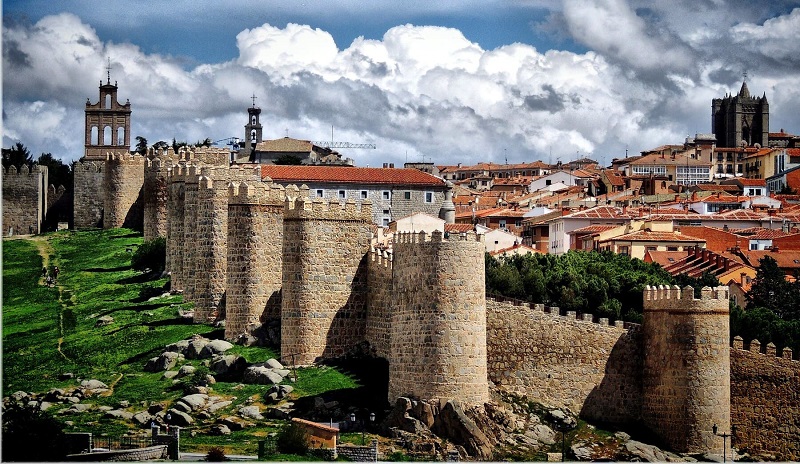ISABEL RUBIO ARROYO | Tungsteno
The most famous wall in the world is probably the Great Wall of China. If this fortification stand out for anything, it’s for its stratospheric dimensions. It has thousands of watchtowers and collectively stretches more than 21,000 kilometres in length, which is almost twice the diameter of the Earth and half its circumference.
But this is not the only impressive wall on the planet. Many other walls surround cities and leave visitors speechless, including Avila in Spain, Ston in Croatia and Carcassonne in France.
The walls of Ávila
The walls of Ávila are among the best preserved in the world. They have a perimeter of 2,516 metres and have 87 semi-circular towers or turrets, nine gates and 2,500 merlons (vertical projections). This ancient megastructure built in a city in the centre of Spain with a population of around 60,000, has a history of more than 2,000 years. Excavations show that walls were first built in the 1st century AD, when the area is thought to have been inhabited by both the Vettones and the Romans.
The walls have undergone several reconstructions, such as those ordered by Alfonso VI (1048-1109) after the conquest of Toledo, and those ordered by Alfonso VIII (1155-1214), which are the walls that have survived to the present day. According to the Ávila tourism website, at that time the town needed to defend itself.
"In the 16th century, they continued to fulfil the functions of health security and economic control, and reforms were carried out to repair them, but once the danger of war had disappeared, it was decided to dismantle of the additional defences (such as the barbican and the moat), which proved ineffective in the face of the military machinery of the time," they add.
At the end of the 19th century, some intellectual circles were in favour of demolishing the walls, as was being done in other European cities, as they were considered an obstacle to urban development. But the city council was determined to preserve them. The walls were declared a World Heritage Site by UNESCO in 1985, along with the old town and several churches outside the walls. Today, 1,700 metres of this megastructure can be visited.
The walls of Ávila measure 2,516 metres long and have 87 towers and nine gates. Credit: Come to Spain
The city walls of Ston
The city walls of Ston consist of the main walls and three forts, 41 towers, seven bastions, four pre-walls and a water-filled moat that extends around some of the edges. Construction began in the early 16th century in this maritime town in southern Croatia. "It took almost four centuries to finish these complex defence walls, as the builders had to adapt to the rough terrain and advancements in warfare technology," explains the official Dubrovnik heritage website.
The constant threat to the inhabitants of Dubrovnik prompted them to start building defensive walls in 1333. This construction was to become the second longest wall in Europe, after Hadrian's Wall. These walls were last used for defensive purposes in the 19th century, and are now a popular tourist destination of incalculable architectural and cultural value.
The walls of Ston are the second longest in Europe. Credit: Explore Croatia
The ramparts of the city of Carcassonne
Among the best-preserved medieval fortifications are the city walls of Carcassonne in France. Declared a UNESCO World Heritage Site in 1997, this city looks like something out of a medieval fantasy novel, according to the French National Monuments Centre. "Between the 3rd and 5th centuries, Carcassonne was attacked by Visigoths, Saracens and Franks. As a result, the city was equipped with a Gallo-Roman enclosure, featuring horseshoe-shaped towers and wide bays," they say.
In the 13th century, Carcassonne was once again besieged, this time during the bloody crusade against the Albigensians. In order to reinforce its strategic position, an extensive 1,600 metres long outer rampart was built. It was at this time that the town took on its present appearance. During the reigns of Philip III the Bold and Philip IV the Fair, the fortifications were modernised. The walls were fitted with loopholes for crossbow firing and new gates were built. Today, the two concentric walls have a total of three kilometres of ramparts and 52 towers. The views from the top are breathtaking. They include a unique panorama of the medieval town, the vineyards and the Pyrenees.
Carcassonne is surrounded by a double medieval wall. Credit: Wonderliv travel.
These are just some of the most impressive city walls in the world. Others such as the walls of Cartagena de Indias in Colombia, York city walls in the UK, or Itchan Kala in Uzbekistan should also be on this list. All of them have unique characteristics but were built with the same purpose: to protect the cities and their inhabitants from external attack.
Tungsteno is a journalism laboratory to scan the essence of innovation.
